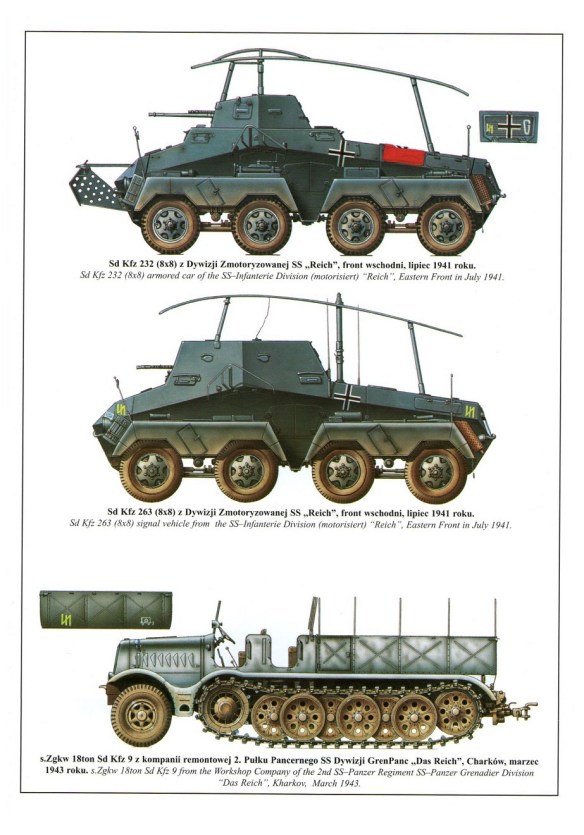
The SS-Verfügungstruppe, combat support force, or SS-VT was created in 1934 from the merger of various Nazi and right-wing paramilitary formations. Two regiments were formed, in northern Germany the SS-Standarte “Germania”, and in southern Germany SS-Standarte “Deutschland”.
In Berlin-Brandenburg they were incorporated into the SS-Leibstandarte Adolf Hitler. SS-Verfügungstruppe was considered an armed wing of the General-SS and as a part of the Nazi party, not of the Wehrmacht.
In 1940, after the invasion of France, V-Division was given the name “Reich”, at the same time, “Reich” and other SS-VT units, were subordinated to the new Kommandoamt der Waffen-SS and from then on called the Waffen-SS.
It was not until after the start of the Russian campaign, “Operation Barbarossa”, that the Division got its final name, “Das Reich”.
“Das Reich” SS Panzer Grenadier Division at Kursk
Of the three SS divisions in the battle, Das Reich was sort of in the middle between the other two when it came to the transition process to a full panzer division.
Das Reich 2nd SS Panzer Regiment: Like with LAH, Das Reich’s 1st Battalion was back in Germany undergoing training in the new Panther tanks. When it left in the late spring of 1943, it left all of its tanks with the regiment, thus allowing the 2nd Battalion to be at full strength. The 2nd Battalion was organized into four companies, each with four platoons. However, there were too many tanks for the 2nd Battalion to contain in its organization so an unusual procedure was implemented to alleviate this overage of tanks. The Das Reich SS Motorized Anti-Tank Battalion was stripped of all of its Marders and the command personnel and the organization were used to create a temporary panzer battalion for the leftover tanks. The 2nd Battalion had about 18 Pz IVF/2, 24 Pz IIIJ, and 5 command tanks operational at the time of the battle. The Heavy Tank Company started the day with one operational Tiger tank but during the morning a second Tiger tank returned from the field repair shops so there were two of them when battle was joined. Of these one was knocked out in the day’s combat (it was hit 83 times!).
Das Reich 2nd SS Panzer Jager Battalion: This was the proper name of the division’s motorized anti-tank battalion. The Marder II companies that were part of the battalion were parceled out to other units in the division. One company went to the assault gun battalion where it became the 4th Company in that unit. The other two went to the panzer grenadier regiments, one to each, to become part of their 14th Companies. The battalion, as a tank unit, was organized into three companies of three platoons each. This battalion was equipped with captured T-34c tanks. It is not clear whether there were two companies of T-34’s and one company of Pz IIIJ’s or one company of T-34’s and two companies of Pz IIIJ’s. Different sources list both types. The 2nd Panzer Jager Battalion had about 15 T-34c, 10 Pz IIIJ, and 2 command tanks at the time of the battle.
Das Reich SS Artillery Regiment: The artillery regiment had four battalions. The 1st and 2nd Battalions were standard 105mm howitzer battalions of two batteries each. The 4th Battalion was a mixed battalion of two batteries of 150mm howitzers and one battery of 105mm guns. The regiment used six gun batteries instead of the usual four gun batteries of other divisions, thus every two batteries. The 3rd Battalion was the self-propelled battalion with three 105mm batteries. The self-propelled artillery pieces were actually experimental ones utilizing captured French tank chassis. These vehicles were hand-me-downs from the regular Army panzer divisions which had received their Wespe and Hummel vehicles.
Last Actions
Division Das Reich had a combat strength of 1498 men and 11 Panzers on 7th April, on 10th it reported 15 Panthers, 11 Panzer IVs, 4 Jagdpanzers IVs, 1 Jagdpanther and 8 Flakpanzer IVs (probably both operational and under repair). Other two divisions that formed the II.SS-Pz.Korps: -3.SS-Pz.Div. (1004 men and 6 Panzers) -6.Pz.Div. (1235 men and 8 Panzers) Gumpoldskirchen and Baden were captured (by Russians) on 4th April. Hstuf. Franz-Josef Dreike (Kdr.SS-Flak.Abt.2) and Stubaf. Hans Hauser (KG Hauser) received KCs for their actions at Laaer Berg and Münchendorf.
The last combat actions of the Division as a whole were around the 13th April 1945 near to the Floridsdorfer Bridge in Vienna.
One of the last Pzkw. IV tanks of Panzerdivision “Das Reich” guards the Vienna side of the Floridsdorfer Bridge.
VIENNA, AUSTRIA, 12 APRIL 1945
To buy time for the scattered remnants of the 2nd SS Panzer Division to escape north of the Danube, a small rearguard was left to protect the south end of the bridge and engage any Russian forces attempting to cross the Danube. Lt. Arno Giessen was in command, with 97 confirmed tank kills he was considered the best man for the job. With his small force, his prospects for slowing the Russian Juggernaut seemed small.
Superb leadership overcame superior numbers once again. Each time a Russian tank came into view the Germans would zero in on it and destroy it before the Russian infantry could intervene. When his Panther ran out of fuel, Lt. Giessen went stalking Russian tanks on foot with Panzerfausts. Before dawn on the 13th of April Lt. Giessen added 14 kills to his record. Lt. Giessen’s actions allowed the majority of the division to escape across the Danube. He surveyed his destroyed tanks as his remaining men crossed the bridge. Lt. Giessen crossed the bridge and engineers sent it tumbling into the Danube. Lt. Giessen was the last man out.
By early May 1945 the Division had ceased to exist as a cohesive unit, the Der Fuehrer Pz. Gren. Regt were sent to Prague, the Deutschland Pz. Gren. Regt were fighting in Austria and the Div HQ and other Div units including the Panzer Regt were in action near Dresden.